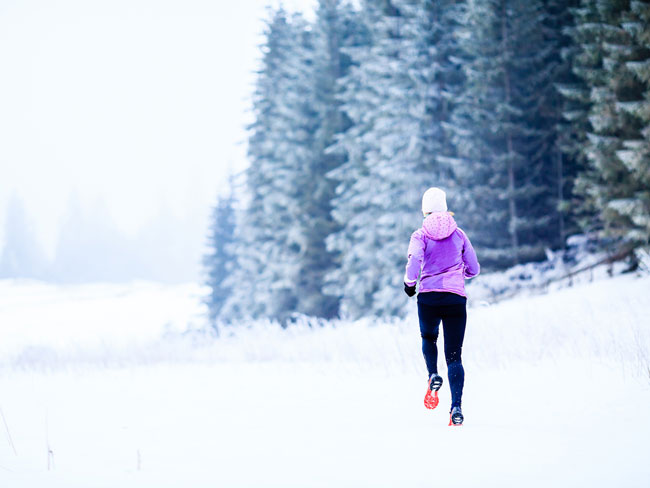Winter Runner-land
- By Jonanna Widner
- Reading Time: 4 mins.
 Whether you’re a novice runner or an ultra-marathoner, running in winter nearly always means making some adjustments to your regimen. As the seasons change, so does your gear, your preparation, and your routine. But shifting into the chilly season doesn’t need to be jarring or unpleasant. Whether your winter weather is cold and crisp or decidedly more damp and dismal, all you need are a few tweaks, and you’ll be ready to hit the pavement or running trails while taking advantage of less crowded routes and making the best of winter.
Whether you’re a novice runner or an ultra-marathoner, running in winter nearly always means making some adjustments to your regimen. As the seasons change, so does your gear, your preparation, and your routine. But shifting into the chilly season doesn’t need to be jarring or unpleasant. Whether your winter weather is cold and crisp or decidedly more damp and dismal, all you need are a few tweaks, and you’ll be ready to hit the pavement or running trails while taking advantage of less crowded routes and making the best of winter.
Some of the adjustments you’ll need to make are more obvious. For example, you’ll want to increase how visible you are to drivers, bicyclists, and others on the road by adding a few pieces of reflective gear to your clothing, as well as a headlamp if you’re running in the early morning or evening. In addition, most experts recommend investing in a pair of water-repellent running shoes. And, of course, you’ll want gloves and perhaps an extra or base layer to keep you warm.
But even on cold days, you should resist the urge to bundle up too much. “Your body will heat up as you run, so you don’t need as many layers as you think,” ACE-certified personal trainer Monica Lam-Feist told The FruitGuys. “Stick to the essentials—a headband or hat, gloves, tights, a long-sleeve layer, and a running jacket.” According to Runners’ World, a good rule to consider when calculating how the temperature will feel to you once you’re actually running is to simply add 10 to 20 degrees to the outside temperature. This will give you a better idea of how you’ll fare once you’ve set your pace.
Get tips for your office
Be an office hero!
Although you’ll work up plenty of body heat as you run, what about those chilly first few minutes—the ones that deter many people from getting out there in the first place? Many runners warm up inside before heading out the door. Try jumping rope, jumping jacks, or even running in place for a few minutes prior to going outside. Marathon runner John Gagliardi—who trains through harsh Chicago winters—goes a step further: “I apply a little Cramer Red Hot to jump-start my muscles,” he told The FruitGuys, referring to the petrolatum-based analgesic used by some athletes to help them both warm-up before they exercise and relieve aching muscles afterward. “A little dab goes a long way—once you warm up, it feels like you’ve bathed in jalapenos!”
It may seem counter-intuitive, but during winter, dehydration is still a concern. “You may not think that you’re sweating because of the cold,” says Lam-Feist, “but you’re losing fluid just like it’s summer. Make sure to hydrate before and rehydrate after each run.”
Also counter-intuitive: Unless you’re running in extreme conditions where snow and/or ice are unavoidable, you probably won’t need shoes with any more traction than your summer shoes.

“I stick with my usual training shoes, and as long as I avoid icy patches, I don’t have any trouble,” says Gagliardi, who has been running for 40 years. “And, if you’re running on snow-packed roads, don’t worry about speed, just play it safe, dial it down, and get your miles in. There will be plenty of time to ramp-up your training in the spring.”
Paul Ronto, the director of content at RunRepeat.com, recommends that you stick with the same training pace and goals you have the rest of the year. “Basically, any marathon or big race before August 1st has the potential to see training runs that fall within winter-like conditions,” he says, “so it’s crucial to be prepared to run in chilly or snowy weather. Skipping training days, especially early on in your training schedule, can lead to injuries and problems as you get closer to race day.”
Still, he recommends starting out slow to gauge road or trail conditions in winter conditions. “I’d advise taking it slow at the beginning of every run to get a feel for the conditions, but not changing your form. Changing your form is something that could lead to injury down the road.”
A final piece of advice: No matter what type of runner you are, it’s absolutely worth getting out there in the winter months, whether you run one mile or 26. “Running in the winter can be a total joy,” Ronto says. “You’ll see fewer people, gain a new perspective and view of your city, and burn countless calories while everyone else is at home sitting on their couches.” Wintertime running may offer a chilly payoff, but a worthwhile payoff nonetheless.
Want farm-fresh fruit?
We've got you covered.
Jonanna Widner lives in Portland, OR, where she writes about sports, music, travel, and fitness.


